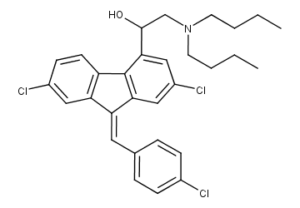Lumefantrine CAS NO 82186-77-4 Inquire about Lumefantrine
Tecoland supplies Lumefantrine bulk active pharmaceutical ingredient (API) to the pharmaceutical industry. Our Lumefantrine is manufactured by cGMP compliant facility. Welcome to contact us for further details including current DMF status for the product and up to date regulatory status of the manufacturing facility. We look forward to assisting you with your research and development projects.
What is Lumefantrine?
Lumefantrine is an antimalarial agent used to treat acute uncomplicated malaria. It is administered in combination with artemether for improved efficacy. This combination therapy exerts its effects against the erythrocytic stages of Plasmodium spp. and may be used to treat infections caused by P. falciparum and unidentified Plasmodium species, including infections acquired in chloroquine-resistant areas.
Lumefantrine, along with pyronaridine and naphtoquine, were synthesized during the Chinese Project 523 antimalaria drug research effort initiated in 1967; these compounds are all used in combination antimalaria therapies.
Chemical Formula
C30H32Cl3NO
Indication
Lumefantrine and artemether combination therapy is indicated for the treatment of acute uncomplicated malaria caused by Plasmodium falciparum, including malaria acquired in chloroquine-resistant areas. May also be used to treat uncomplicated malaria when the Plasmodium species has not been identified. Indicated for use in adults and children greater than 5 kg.
Pharmacodynamics
Lumefantrine is a blood schizonticide active against erythrocytic stages of Plasmodium falciparum. It is thought that administration of lumefantrine with artemether results in cooperate antimalarial clearing effects. Artemether has a rapid onset of action and is rapidly cleared from the body. It is thus thought to provide rapid symptomatic relief by reducing the number of malarial parasites. Lumefantrine has a much longer half life and is believed to clear residual parasites.
Mechanism of action
The exact mechanism by which lumefantrine exerts its antimalarial effect is unknown. However, available data suggest that lumefantrine inhibits the formation of β-hematin by forming a complex with hemin and inhibits nucleic acid and protein synthesis.
Toxicity
Common side effects of combination artemether/lumefantrine therapy in adults include headache, anorexia, dizziness, and asthenia. Common side effects in children include pyrexia, cough, vomiting, anorexia, and headache. Possible serious adverse effects include QT prolongation, bullous eruption, urticaria, splenomegaly (9%), hepatomegaly (adults, 9%; children, 6%), hypersensitivty reaction, and angioedema.
Disclaimer:
Information on this page is provided for general information purposes. You should not make a clinical treatment decision based on information contained in this page without consulting other references including the package insert of the drug, textbooks and where relevant, expert opinion. We cannot be held responsible for any errors you make in administering drugs mentioned on this page, nor for use of any erroneous information contained on this page.
External Link:
- Lumefantrine | DrugBank Online. (n.d.). DrugBank. https://go.drugbank.com/drugs/DB06708
- Wikipedia contributors. (2020, October 17). Lumefantrine. In Wikipedia, The Free Encyclopedia. Retrieved 18:43, February 2, 2021, from https://en.wikipedia.org/w/index.php?title=Lumefantrine&oldid=983950505